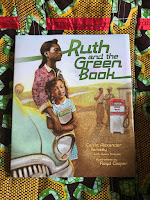Victor Green, a postal worker, saw a need in his community and created a book that would help African American travelers navigate around and through Jim Crow laws in the south as well as unwritten laws in northern states and throughout the Midwest in sundown towns. First published as The Negro Motorist Green Book and later as The Negro Travelers' Green Book. The books were published over a 30 year period (1936-1966) and in that time expanded to include not only the United states but International travel. Later, a Pullman porter, Clarence M. Markham Jr. created a similar book Negro Traveler and Conventioneer. The genius of both men's creations is they joined a long history of African Americans who were challenged to "make a way out of no-way." Their contributions helped many African Americans travel safely across our country informing them of safe housing, food, service stations, restrooms and shopping.
I decided to write a post on the Green book and our family's experience with it. So, I phoned my Aunts who'd grown up in Memphis and moved to Nashville in the late 60's/early 70's. One Aunt is in her late 70's and the other in her late 80's. The conversation began, "tell me about your experiences with the Green book." The response was "What Green book?...what is that?" I will also add here that these are not just two old Southern women with no life experience, my oldest Aunt was a nurse and the other a college professor for 45 plus years with a PhD. They could recount experiences in places where they were refused service and of places that did not welcome Blacks, but did not know of The Green book. We traveled as a family and my Mother traveled frequently with the work of the Episcopal church and I don't recall our family talking about the Green book. This lead me to believe, and I will admit without researching it, that this was not something that all African Americans knew about. Many did, yes, but growing up, this was not something I was made aware of and did not learn about until I was an adult. I am cautious of stories of African American history that are painted with a broad stoke of "all Black people..." I would instead use 'many' or ''some.' While many African Americans share histories and experiences our stories are not all identical.
There were places that we did not go but it was just understood. As a child you did not question why your parents never frequented certain places, I suspect in hindsight they were protecting us. Many Black communities were close and people relied on referrals from neighbors and friends as to where they could shop, eat, buy gas, and sleep at home and when they traveled. The interesting thing I did learn from my Aunts was that several things we routinely did as a family when we traveled were most likely the result of our parents having grown up in the south with Jim Crow laws and their personal travel experiences. For example, before we left home the last thing we did was go to the bathroom. When we traveled we packed our own food for long trips. We did not frequent a lot of restaurants but I thought this was because Mama and Daddy were being thrifty. (probably partially true.) While I have no memory of our family using the Green book, I have a friend close to my age who remembers her family using the Green book. Her family were residents of New York and they used it traveling south. She remembers the family lunch packed in a shoe box. My friend still has her family copy of the Green book and she uses it to share her personal stories and educate others.
I taught a lesson this past week on the Green book to a group of Kindergartners. I used the children's book Ruth and the Green book. We discussed before, "What would you do if, when traveling with your family you couldn't stop to eat at a restaurant or use the bathroom or put gas in your car?" They had lots of ideas as they tried to process the whole idea of being excluded and the unfairness of it. My favorite answer was "change the laws." After we read and discussed a bit more, the youngsters created their own Green book to share and educate their families. Inside was a photo of Victor Green, they drew pictures of a post office to remind themselves of Mr. Green's original profession before he became a publisher and travel critic. They drew brown people in cars and maps like they had seen in the story. They wrote in their best Kindergarten writing details to remember. It was a good lesson. These children learned about the Green book before they became adults, they learned about the genius of Victor Green and how he had helped his people. Do you have experiences with the Green book? I'd love for you to share them.














Thank you for sharing, Debbie - I most enjoy the wonderful Nelson family pix.
ReplyDelete